<< Previous | Displaying results 4051-4100 of 6769 for "" | Next >>
A March 3, 1967, New York Times article about Simon Wiesenthal entitled, "Relentless Nazi-Hunter."
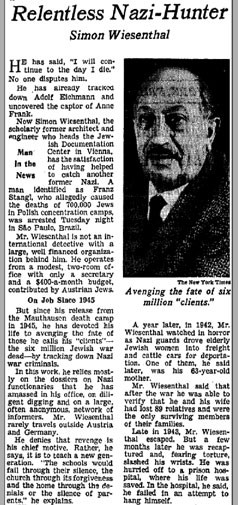
Single-use entry pass for the trial of Adolf Eichmann in Jerusalem, Israel. June 8, 1961.
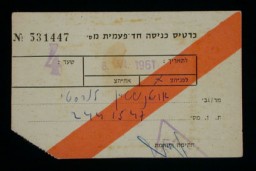
International Military Tribunal entry pass for Benjamin Ferencz, war crimes investigator and later chief prosecutor in the Einsatzgruppen Trial.
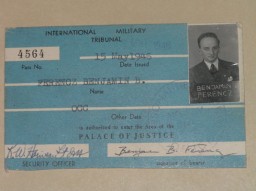
Pass issued to Benjamin Ferencz, war crimes investigator and later chief prosecutor in the Einsatzgruppen Trial. This pass granted the bearer free movement within the US-occupied zone of postwar Germany.
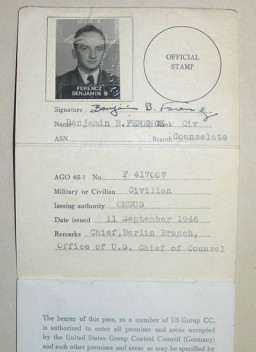
Eugenics poster entitled "The relationship between Jews and Freemasons." The text at the top reads: "World politics World revolution." The text at the bottom reads, "Freemasonry is an international organization beholden to Jewry with the political goal of establishing Jewish domination through world-wide revolution." The map, decorated with Masonic symbols (temple, square, and apron), shows where revolutions took place in Europe from the French Revolution in 1789 through the German Revolution in 1919. This…

Illustration from cover of a German anti-Masonic pamphlet by Friedrich Haffelbacher, entitled "Das Todesurteil ueber die Freimaurerei in Deutschland" [The Death Sentence for Freemasons in Germany].
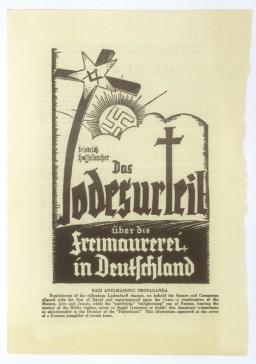
A special issue of Serbian stamps bearing antisemitic and anti-Masonic themes dating from the German occupation. The series was issued for an exhibition on Jews and Freemasons in Belgrade in 1942.
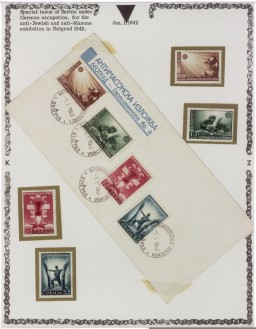
Brochure published by the Unitarian Service Committee describing its relief mission in Nazi-occupied Europe.
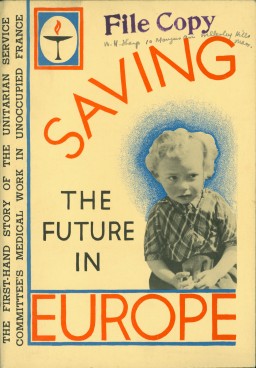
This Singer sewing machine was used by shoemakers in the Lodz ghetto, Poland. As early as May 1940, the Germans began to establish factories in the ghetto and to utilize Jewish residents for forced labor. By August 1942, there were almost 100 factories within the ghetto. The major factories produced textiles, especially uniforms, for the German army.
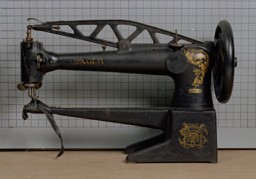
Julien Bryan stored his still photo negatives from Nazi Germany 1937 and Poland 1939 in these carefully marked metal canisters.
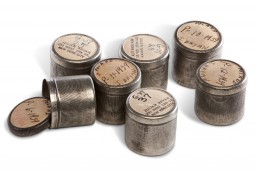
Two of Julien Bryan's Nazi Germany 1937 contact print booklets of still photographs organized by camera roll. Bryan used these prints to select and crop images for publication or distribution and annotated the covers.

Many of Julien Bryan's original 35mm nitrate film rolls were actively deteriorating when the United States Holocaust Memorial Museum acquired the collection in 2003.
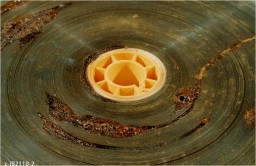
One of the primary documents used to calculate the number of deaths in the Nazi "euthanasia" program is this register discovered in a locked filing cabinet by US Army troops in 1945 at a killing site in Hartheim, Austria. The right page details by month the number of patients who were "disinfected" in 1940. The final column indicates that 35,224 persons had been put to death that year.

A red and yellow floral handkerchief belonging to Judit Gondos that she took with her when she left Budapest on the Kasztner rescue train.

Violin owned by Rita Prigmore and originally used by her father, who played with his four brothers in a band in Germany before World War II. Rita and her family were members of the Sinti group of Roma (Gypsies). She and her twin sister Rolanda were born in 1943. Rolanda died as a result of medical experiments on twins in the clinic where they were born. Rita and her mother survived the war and moved to the United States, before returning to Germany to run a Sinti human rights organization that sought to…
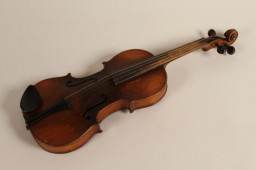
This small patterned hooked rug was used as a shoe mat in the wagon of Rita Prigmore and her family when she was a child in Wurzberg, Germany, after World War II. Rita and her family were members of the Sinti group of Roma (Gypsies). She and her twin sister Rolanda were born in 1943. Rolanda died as a result of medical experiments on twins in the clinic where they were born. Rita was returned to her family in 1944. She and her mother survived the war and moved to the United States, before returning to…
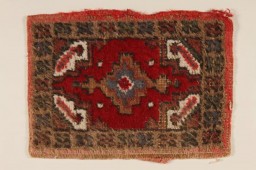
These blacksmith's bellows were used by Romani (Gypsy) artisan Juri Cervenuak in Trebisov, Slovakia, in 1939. Many Roma traditionally worked as craftsmen and were blacksmiths, cobblers, tinsmiths, horse dealers, and toolmakers.
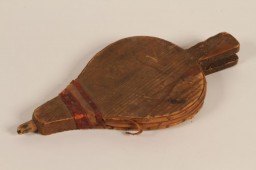
This Olympic torch holder was used during the 1936 Berlin Olympics. It is engraved with the 1936 Olympics torch relay route from Olympia, Greece, to Berlin, Germany.
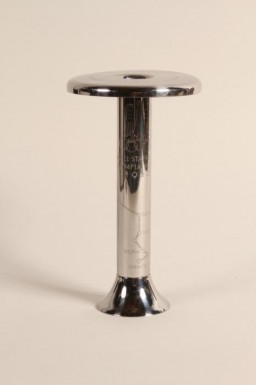
In 1963, the German Democratic Republic (DDR) issued this postage stamp to commemorate the Treblinka killing center. This was the first stamp of a series issued annually by the DDR under the name Mahn- und Gedensksatte (Remembrance and Memorial Center) in remembrance and commemoration.
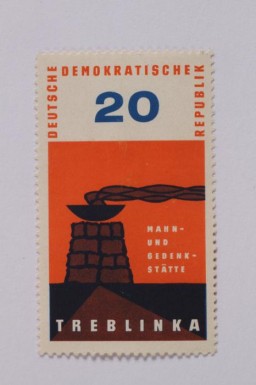
In December 1939, German authorities required Jews residing in the Generalgouvernement (which included Krakow) to wear white armbands with blue Stars of David for purposes of identification. The armband pictured here was donated to the United States Holocaust Memorial Museum in 2001 by Akiva Kohane.
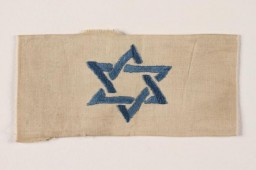
Nazi banner with a swastika. The swastika became the most recognizable symbol of Nazi propaganda, appearing on the Nazi flag, election posters, arm bands, medallions, and badges for military and other organizations.
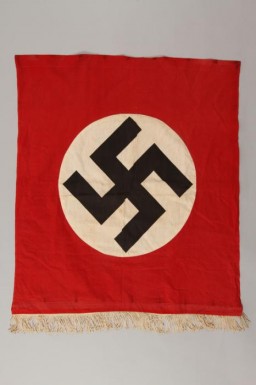
Jewish teenager Ava Hegedish drew this poignant picture of her mother's well-worn shoes while in hiding. It was drawn while Ava was in hiding at a farm near Belgrade, Yugoslavia (now Serbia), between 1941 and 1944. Once Nazi Germany and its Axis partners partitioned Yugoslavia and Belgrade fell under German control, Ava’s father thought the family’s best chance of survival was to separate and go into hiding. Ava ended up at a farm with some extended-family Serbian relatives. Because she…
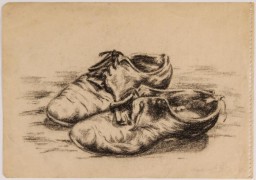
This paper tag identified bedding belonging to Alice (Lisl) Winternitz when she was deported from Prague, Czechoslovakia, to the Theresienstadt ghetto in June 1942.
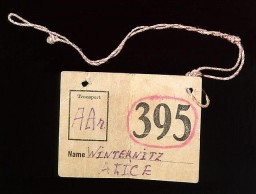
White armband with a Star of David embroidered in blue thread, worn by Dina Offman from 1939 until 1941 while in the ghetto in Stopnica, Poland.
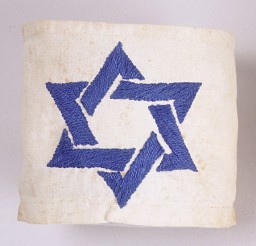
White armband with a Star of David embroidered in blue thread, worn by Dina Offman from 1939 until 1941 while in the ghetto in Stopnica, Poland.
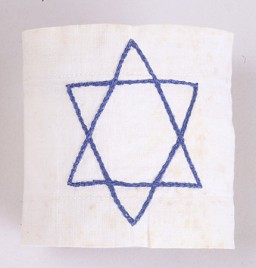
Zofia Burowska (Chorowicz) donated this doll, which dates from the 1930s, to the United States Holocaust Memorial Museum. Zofia's parents gave her the doll before the war and she kept it with her in the Wolbrum and Krakow ghettos, Poland. The doll and some of her family's other belongings were left with non-Jewish friends for safekeeping. Zofia was deported to a forced-labor camp for Jews near Krakow, to the Skarzysko-Kamienna camp (also in Poland), and then to the Buchenwald concentration camp in Germany,…
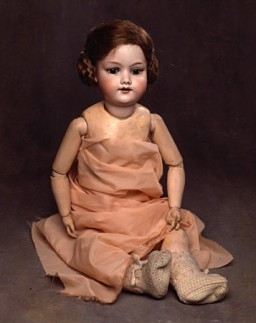
Leon Jakubowicz, a shoemaker by training and a native of Lodz, began constructing this model of the Lodz ghetto soon after his arrival there from a prisoner-of-war camp in April 1940. The case holds a scale (1:5000) model of the ghetto, including streets, painted houses, bridges, churches, synagogue ruins, factories, cemeteries, and barbed wire around the ghetto edges. The model pieces are made from scrap wood. The case cover interior is lined with a collection of official seals, a ration card, and paper…

SS Major General Juergen Stroop, commander of German forces that suppressed the Warsaw ghetto uprising, compiled an album of photographs and other materials. This album, later known as "The Stroop Report," was introduced as evidence at the International Military Tribunal at Nuremberg. Here, its cover is marked with an IMT evidence stamp.
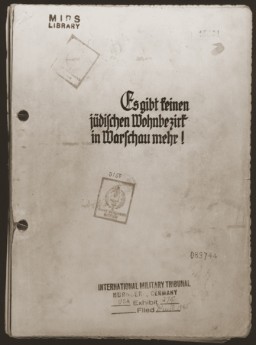
This tan backpack was used by Ruth Berkowitz to carry her belongings as she fled from Warsaw via Lithuania and the Soviet Union to Japan. Most of her possessions were confiscated by both the Nazis and the Soviets during her journey. [From the USHMM special exhibition Flight and Rescue.]
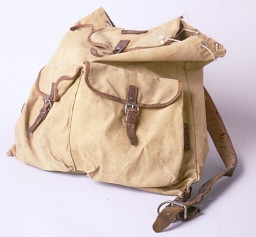
Leon Jakubowicz, a shoemaker by training and a native of Lodz, began constructing this model of the Lodz ghetto soon after his arrival there from a prisoner-of-war camp in April 1940. The case holds a scale (1:5000) model of the ghetto, including streets, painted houses, bridges, churches, synagogue ruins, factories, cemeteries, and barbed wire around the ghetto edges. The model pieces are made from scrap wood. The case cover interior is lined with a collection of official seals, a ration card, and paper…
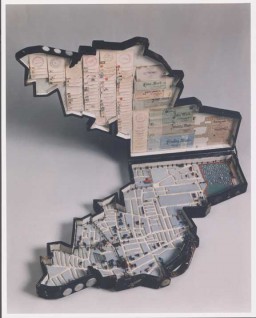
Survivors of the camps lacked even basic possessions, such as footwear. The Red Cross issued these United States Army boots to Jacob Polak in June or July 1945 after his repatriation to the Netherlands.
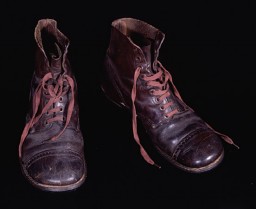
A pair of candlesticks, bought in Poland and used every Friday evening during observance of the Jewish Sabbath. Polish Jewish refugees fleeing the German invasion of Poland in 1939 carried these candlesticks with them to Vilna.
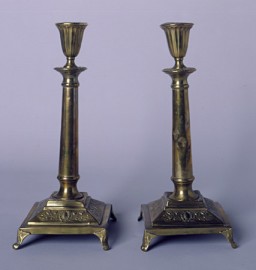
A suitcase used (ca. 1939) by a Jewish refugee fleeing Nazi-occupied Europe to Japan. The suitcase is covered with labels from various stops along the journey, including one from a hotel in Moscow (top left), one for the NYK Line (top middle), and six from hotels throughout Japan. [From the USHMM special exhibition Flight and Rescue.]
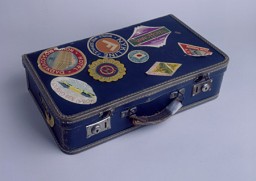
During the 1943 liquidation of the Lvov ghetto, dozens of Jews fled into the city sewers to escape death. Eight-year-old Krystyna Chiger (later Kristine Keren) hid with her family and 16 others beneath the city's streets for 14 months, during which she wore this sweater.
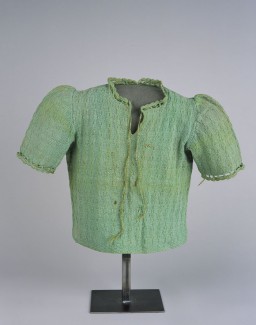
A blue and white child's dress worn by Sabina Kagan while living in hiding with the Roztropowicz family in Radziwillow, Poland, during World War II. Her rescuers used doll's clothing to make this dress. Sabina was just an infant when SS mobile killing squads began rounding up Jews in the Polish village of Radziwillow in 1942. Her parents persuaded a local policeman to hide the family. The policeman, however, soon asked the Kagans to leave but agreed to hide baby Sabina. Her parents were captured and…
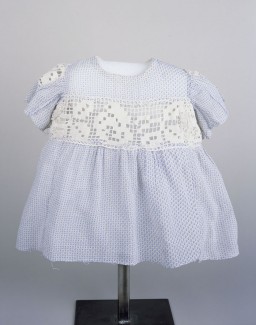
A child's dress embroidered with red and blue flowers with small green leaves. This dress was hand embroidered by Lola Kaufman's mother in the Czortkow ghetto. Lola (born Lea Rein) wore this dress when she went into hiding. Lola was hidden first under a bed in the house of the woman who used to deliver milk to the family, then in a dugout under a cellar of a barn where she joined three other Jews in hiding. In March 1944, the Soviets liberated the area. The hidden Jews left their hideout in the middle of…
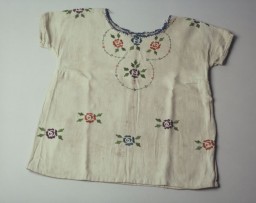
After being deported from Theresienstadt to the Auschwitz concentration camp in 1942, Karel Bruml wore this cap as a forced laborer in the Buna synthetic rubber works located in the Buna-Monowitz section of the camp.
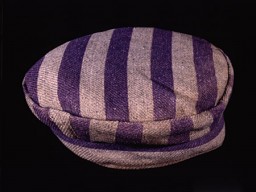
Abraham Lewent, who had been sent from the Warsaw ghetto to Majdanek and later transferred to several concentration camps in Germany, wore this jacket as part of the uniform issued to him upon his arrival in the Buchenwald concentration camp in 1944.
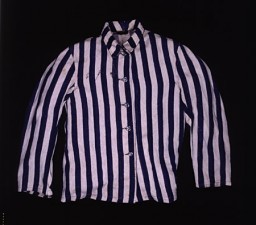
A blue and gray striped jacket from the Flossenbürg concentration camp. The letter "P" on the left front of the jacket indicates that it was worn by a Polish, non-Jewish prisoner. "P" stands for "Pole" in German. The jacket was donated to the United States Holocaust Memorial Museum by the prisoner who wore it, Julian Noga.
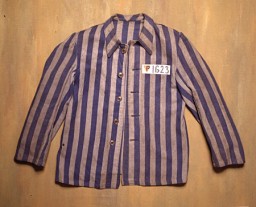
Hana Mueller altered this skirt issued to her in the Auschwitz concentration camp in 1944 by using the hem to make pockets.
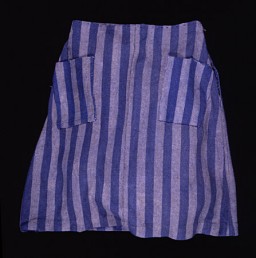
Yona Wygocka Dickmann fashioned this jackknife from aluminum and part of a saw after the SS transferred her from Auschwitz to forced labor at an airplane factory in Freiburg, Germany, in November 1944. She used the knife to extend her daily ration of bread by cutting it in half.
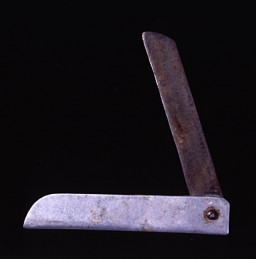
This photograph shows some of the 190 granite blocks donated to the United States Holocaust Memorial Museum by the Mauthausen Public Memorial in Austria. The Nazis established the Mauthausen concentration camp in 1938 near an abandoned stone quarry. Prisoners were forced to carry these granite blocks up more than 180 steps. The small blocks weighed between 30 and 45 pounds each. The larger blocks could each weigh more than 75 pounds. Prisoners assigned to forced labor in the camp quarry were quickly worked…
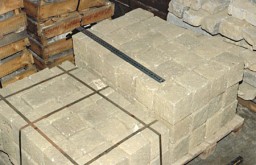
This casting of a gas chamber door in the Majdanek camp, near Lublin, Poland, was commissioned by the United States Holocaust Memorial Museum. Each gas chamber in Majdanek was fitted with an airtight metal door and was bolted shut before gas entered the chamber inside. SS guards could observe the killing process through peepholes in the upper center of the door.
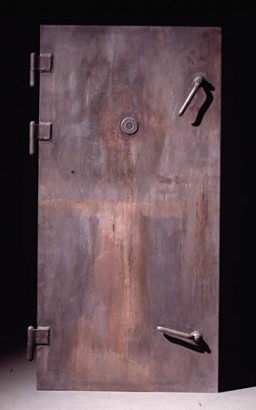
This taffeta and cotton skirt dates from the 1920s. It belonged to a Romani (Gypsy) woman who was born in Frankfurt, Germany, and who lived in Germany before the war. She was arrested by the Nazis and interned in the Auschwitz, Ravensbrück, Mauthausen, and Bergen-Belsen camps. She died in Bergen-Belsen in March 1945, shortly before the camp's liberation. Her husband and two of her six children were also killed in the camps.
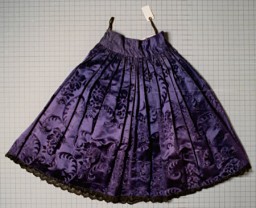
Set of tefillin in an embroidered bag. Tefillin are ritual objects worn by religious Jews during weekday morning prayers. This set was found on the body of a death march victim, who was buried near Regensburg, Germany.
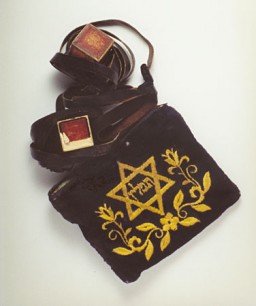
Soviet forces liberated the Sachsenhausen concentration camp in April 1945. In the camp, Soviet soldiers found this German edition of the Old and New Testaments on a dead prisoner, a Jehovah's Witness. The bible was sent to the prisoner's surviving family members.
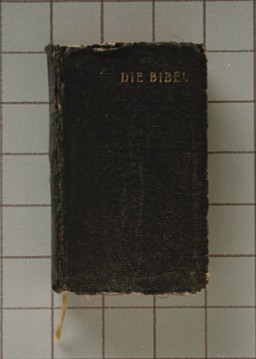
During the war the Japanese flooded Shanghai with anti-American and anti-British propaganda, including this image from a matchbox cover. It depicts a Japanese plane dropping a bomb on the U.S. and British flags. Shanghai, China, between 1943 and 1945. [From the USHMM special exhibition Flight and Rescue.]
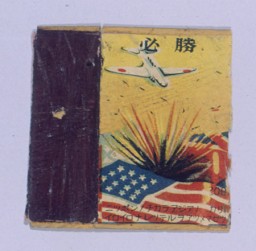
During the war the Japanese flooded Shanghai with anti-American and anti-British propaganda, including this image from a matchbox cover. It depicts Japanese planes flying in formation over the U.S. and British flags, with the Japanese flag rising in triumph. Shanghai, China, between 1943 and 1945. [From the USHMM special exhibition Flight and Rescue.]
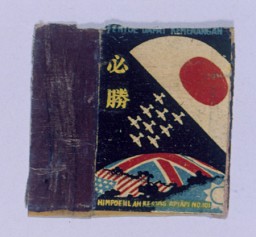
During the war the Japanese flooded Shanghai with anti-American and anti-British propaganda, including this image from a matchbox cover. It depicts a Japanese tank rolling over the U.S. and British flags. Shanghai, China, between 1943 and 1945. [From the USHMM special exhibition Flight and Rescue.]
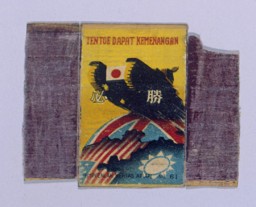
During the war the Japanese flooded Shanghai with anti-American and anti-British propaganda, including this image from a matchbox cover. It depicts United States President Franklin D. Roosevelt--dressed in rags, on a raft in the ocean, and holding onto the U.S. flag--in the view of a Japanese submarine periscope. Shanghai, China, between 1943 and 1945. [From the USHMM special exhibition Flight and Rescue.]
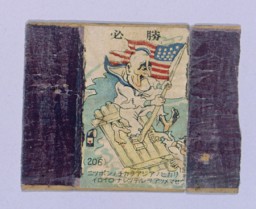
We would like to thank Crown Family Philanthropies, Abe and Ida Cooper Foundation, the Claims Conference, EVZ, and BMF for supporting the ongoing work to create content and resources for the Holocaust Encyclopedia. View the list of donor acknowledgement.